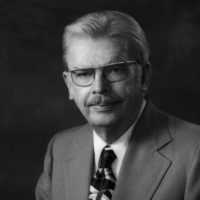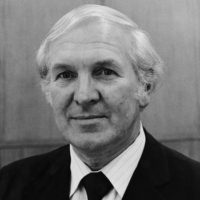
Raymond P. Ahlquist
Medical College of Georgia

J.W. Black
University College of London
For advancing the concept of alpha and beta adrenergic receptors, which opened the door to the development of propranolol.
Raymond Ahlquist
Dr. Ahlquist conceived the theory that there must be two types of receiving mechanisms, or sites, in the cardiovascular system—one type prevailing in the heart, and the other in the blood vessels. These receptors, which receive “messages” from the sympathetic nervous system, were classified and named by him, alpha and beta. Because they are receptors for adrenaline and adrenaline-like substances, they are known as “adrenergic” receptors.
Dr. Ahlquist further postulated that the predominant adrenergic receptors in the heart are of the beta type, and affect its contraction, its rate and its rhythm.
These theoretical concepts were later confirmed by Dr. Ahlquist and other investigators. The drug, propranolol, based on Dr. Ahlquist’s original hypotheses, was later developed by Dr. J.W. Black, and is now widely used here and abroad for the treatment of severe high blood pressure, cardiac arrhythmias, and the agonizing pain of angina pectoris.
Propranolol works by blocking the beta-adrenergic receptors, thus preventing noradrenaline from reaching them. As a result of this blocking process, the heart is not compelled to work as hard nor as fast as it would have, had the noradrenaline reached its receptors, and thus the symptoms of angina pectoris are alleviated. Blocking the beta receptors also brings cardiac arrhythmias and severe high blood pressure under control, although the means by which this functions in the latter condition are not yet clearly established.
For the incisive scientific reasoning which led Dr. Ahlquist to formulate the dual adrenergic receptor theory, which made possible the later development of clinically useful drugs, especially propranolol, this 1976 Albert Lasker Clinical Medical Research Award is given.
For the development of propranolol as a major treatment of heart disease.
J.W. Black
Dr. Black, whose research in beta blockers began in 1958, acknowledges that this work would not have started, but for the existence of the Ahlquist concept of the adrenergic receptor mechanisms—a theory which had been ignored by others for a decade.
Although science had envisioned the possibility of a pharmaceutical beta blocker, no practical application of this concept was achieved until Dr. Black, in 1962, validated this theory by the creation of such an agent, which led, in 1964, to his invention of propranolol.
His design of a drug able to attach itself to the specific beta-adrenergic receptors in the heart, and thus block potentially harmful nonadrenaline in various heart diseases and in severe high blood pressure, now makes it possible to prevent the symptoms and agonizing pain of angina pectoris; reduce excessively rapid heart rates; regulate or normalize life-threatening arrhythmias; reduce the cardiac work load; and lower severe high blood pressure—all with consequent saving of thousands of lives.
Since disorders and diseases of the cardiovascular system are the number one cause of death in the United States today, Dr. Black’s creation of propranolol represents a milestone advance toward the treatment and conquest of these diseases and of severe high blood pressure.
For this tremendous achievement, by which clinical medicine has gained another therapeutic milestone, this 1976 Albert Lasker Medical Research Award is given.
Acceptance Remarks
Acceptance remarks, 1976 Lasker Awards Ceremony
Thank you!
First, I must acknowledge my debt to three people: Dr. Robert A. Woodbury, my chief at the time I started these studies; the late Dr. William F. Hamilton, who sponsored publication of my results; and the late Dr. Bernard Levy, my student, colleague, and friend. An idea, a sponsor, and a true believer are necessary for the birth, nurture and growth of knowledge in biomedical sciences. One new basic idea, for whatever reason put forth, generates other ideas, other information, and other clinically useful drugs or procedures. From adrenergic receptors invented to help teaching has come an important new treatment for hypertension. Unfortunately in the United States this has taken 29 years. This is too long!
Is there anything we can do about this? First, consider new ideas with an open mind. Remember that ideas that do not fit with our present concepts are not necessarily wrong. Second, remember that the United States is not the only place in the world where good research, basic and clinical, is carried out. Finally, remember that the public is willing to accept the fact that all drugs have some risk. The assessment of the benefit to risk factor cannot be a political decision.
The ideas, concepts and drugs for which Dr. Black and I are being honored today have been through this mill. We can hope that other beta-blocking agents and other new clinical uses will have an easier time.
Acceptance remarks, 1976 Lasker Awards Ceremony
I was lucky to be able to visit Philadelphia during the bicentennial celebrations and among my trophies I have Carl Becker’s study of the Declaration of Independence. His analysis of John Locke’s works and their influence on Jefferson tells how Locke said he had made all his discoveries by “steadily intending his mind in a given direction”—a remarkable description of the exciting and satisfying process of problem-solving in science.
In my case, “steadily intending my mind” led, for example, to propranolol—a drug, something useful, applied science, if you like. And yet I can testify that this practical solution to the problem of controlling the work and power of the diseased heart was manufactured from the raw material of so-called pure science. There can be no doubt that without the non-target oriented studies of investigators like Dr. Ahlquist, my work which has led to the beta-receptor antagonists and then, directly stemming from that, to cimetidine for controlling histamine receptors in peptic ulcer disease, would not have been possible. Drug research is, of course, small science. But experience teaches us that a relatively small investment of resources and a big investment of imagination, steadily applied, can yield real benefits to sick people everywhere.
I hope that the selection of propanolol for this award today will be seen as a mere sample of what adventures in pharmacology and medicinal chemistry could do today provided all our energy is not short-circuited by obsession with safety and avoidance of regret. Finally, I wish to acknowledge the privileges of scientific freedom and generous colleagues which I enjoyed at I.C.I., the honor of having been selected to share this award with Dr. Ahlquist, and my great pleasure at being here to accept it today.
